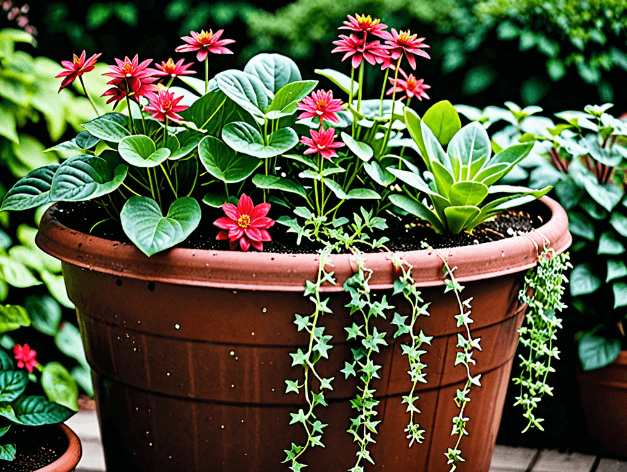Container gardening is a popular method for growing plants in small spaces.
It allows gardeners to cultivate flowers, herbs, and vegetables in pots, making it ideal for urban settings or those with limited outdoor space.
This guide will explore the essentials of container gardening, including the benefits, best practices, and tips for success.
What is Container Gardening?
Container gardening offers a versatile way to grow plants for those with limited space. It involves using containers instead of planting directly in the ground. This method allows for greater flexibility, as containers can be moved to optimize sunlight or manage weather conditions.
It also provides control over soil quality and moisture, making it ideal for urban areas. Essentially, container gardening offers a practical solution for those wanting to grow their own plants, herbs, or vegetables without having access to a traditional garden.
Benefits of Container Gardening
Container gardening offers a wide range of benefits for gardeners and urban dwellers alike. It allows you to maximize limited space by growing plants on balconies, patios, or small yards.
Flexibility is a key advantage, as containers can be moved to take advantage of optimal sun or shade conditions. This method also provides better control over soil types and drainage, crucial for plant health.
Container gardens can help reduce pests and diseases often associated with garden beds. Additionally, they are accessible for people with mobility issues, as the containers can be placed at a convenient height to minimize bending or kneeling.
With the ability to create a mini-garden in any location, container gardening encourages sustainability and enhances urban living spaces.
Choosing the Right Containers
Choosing the right containers is crucial for successful container gardening. Consider the size of the plant’s root system when selecting a container. A larger container can hold more soil, which retains water longer and provides more nutrients.
Material is important too; clay pots are porous and allow better aeration, while plastic pots retain moisture longer. Ensure proper drainage by choosing containers with holes at the bottom to prevent overwatering, which can lead to root rot.
The aesthetics of the container can also complement your overall garden design. Selecting containers that meet the needs of your plants will foster healthier plant growth and maximize space efficiently.
Soil and Fertilization
Using the right soil and fertilization strategies is crucial for container gardening success.Potting mix is ideal as it is lighter than regular garden soil, ensuring good drainage and root aeration.
Ensure the mix includes components such as peat moss, vermiculite, or perlite for better moisture retention.
Fertilization is important since nutrients in containers deplete faster.
Use a balanced, water-soluble fertilizer to nourish your plants regularly.
Organic options like compost or manure tea can also enrich the soil.
Regularly check plant leaves for any signs of nutrient deficiency, such as yellowing, and adjust your fertilization routine accordingly to maintain healthy growth.
Selecting Plants for Containers
Selecting plants for containers involves considering several factors to ensure healthy growth. Choose plants based on the amount of sunlight available, as some thrive in full sun while others prefer shade.
Compact varieties are suitable as they do not outgrow the container quickly. Check the mature size of the plant to ensure it fits comfortably in your space. Combine plants with similar needs in terms of watering and soil conditions.
You can mix ornamental flowers with herbs or vegetables for a visual appeal and practical benefits. Always look for disease-resistant varieties to minimize maintenance demands.
Watering and Maintenance
Proper watering and maintenance are vital for thriving container gardens. Containers dry out faster than garden beds, so monitor soil moisture regularly. Water the plants until water drains from the bottom to ensure adequate hydration.
Frequency may vary based on weather, plant type, and container size. Overwatering can be harmful, so ensure soil is dry before the next watering.
Maintenance involves pruning overgrown parts and removing dead leaves to promote growth. Fertilize periodically according to plant needs, and be vigilant for pests and diseases.
Using mulch on top of the soil can help retain moisture and suppress weed growth.
Common Challenges and Solutions
Container gardening often presents common challenges such as limited root space, which can stunt plant growth. To combat this, choose larger containers and employ frequent repotting to ensure plants have the space they need.
Pests like aphids may also afflict container plants. Use natural predators like ladybugs or insecticidal soap to control infestations.
Poor drainage is another problem that can lead to root rot, so ensure containers have adequate drainage holes and use the right soil mix.
Protect plants from weather extremes by moving them to sheltered areas or using windbreaks and shade covers. These measures can help overcome challenges and result in a successful container garden.
Conclusion: Making the Most of Container Gardening
Container gardening is a flexible and rewarding way to grow plants, offering solutions for urban and limited spaces.
By selecting the right containers and plants, ensuring proper soil and fertilization, and addressing challenges with strategic solutions, anyone can create a flourishing container garden.
Regular maintenance and unique strategies tailored to your environment can turn any small space into a thriving oasis of green.
Embrace the adaptability of container gardening to enjoy fresh produce and a personal green haven, regardless of where you live.
FAQ – Frequently Asked Questions about Container Gardening
What are the benefits of container gardening?
Container gardening allows you to grow plants in small spaces, offers flexibility, and provides control over soil and conditions.
How do I choose the right container?
Select a container based on the plant’s root size, material for drainage, and consider aesthetics for your space.
What soil should I use for container gardening?
Use a high-quality potting mix that includes peat moss, vermiculite, or perlite for good drainage and moisture retention.
How often should I water my container plants?
Water frequency depends on weather, plant type, and container size; usually water when the top inch of soil is dry.
Can all plants be grown in containers?
Most plants can grow in containers, but it’s best to choose compact varieties and check for specific sunlight and space needs.
How can I address pests in container gardens?
Use natural pest controls such as insecticidal soap or introduce beneficial insects like ladybugs to manage pest issues.
What are some common challenges in container gardening?
Challenges include root space limitation, overwatering, and pest control, which can be managed with proper care and maintenance.


